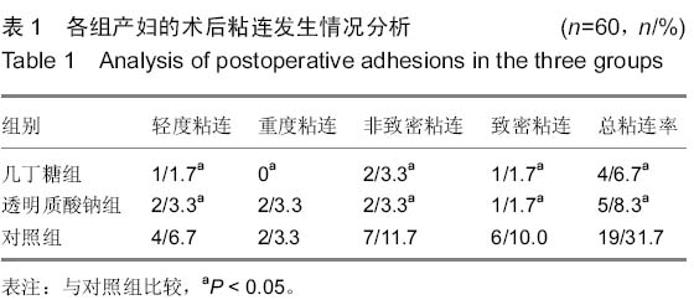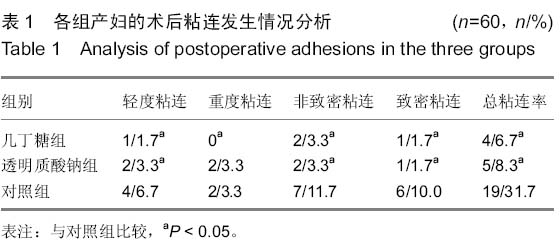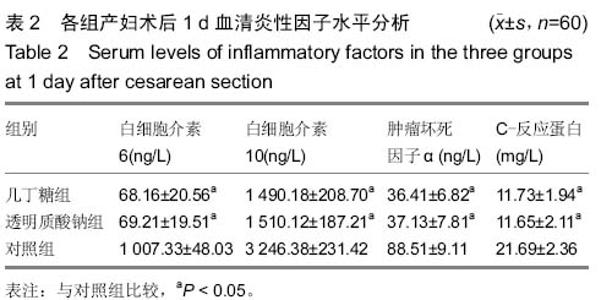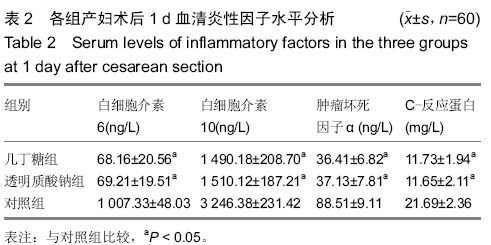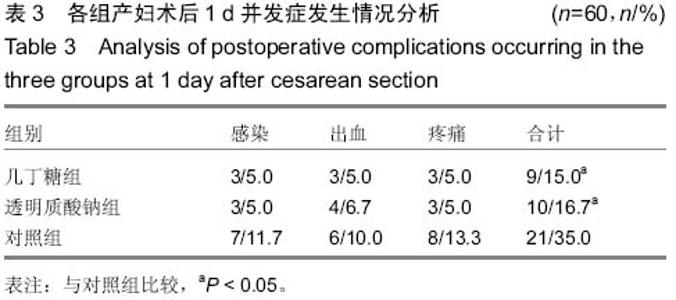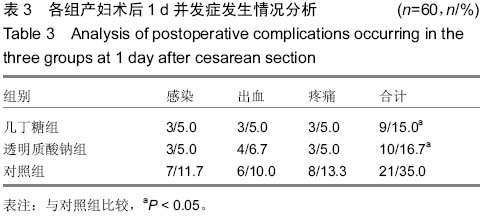| [1] 黄益,郭真真,陈汉威,等.不同防粘连剂在输卵管介入再通术中预防术后再粘连的对比研究[J].中华妇产科杂志,2009,44(11): 821-824.
[2] 陈爱民,侯春林,陈庆泉,等.几丁糖与透明质酸钠治疗肘关节粘连的对比研究[J].中国矫形外科杂志,2002,10(z1):1289-1291.
[3] 王文斌,顾其胜,柯佩琪,等.医用几丁糖基础研究及预防妇产科术后粘连的临床应用[J].上海生物医学工程,2003,24(2):25-28.
[4] 孙嘉阳,秦华东,石铁锋,等.几丁糖与透明质酸钠预防甲状腺术后粘连效果的对比研究[J].现代医学,2010,38(5):481-484.
[5] 沈强,王全,杨俊杰,等.透明质酸钠与几丁糖预防甲状腺术后粘连效果比较分析[J].中国药师,2014,17(2):266-268.
[6] 郭迅,裴明祥,邱福轩,等.医用几丁糖与透明质酸钠预防腹部术后肠粘连的对比研究[J].中国医药指南,2010,8(9):26-27.
[7] 顾超.几丁糖透明质酸钠预防术后肠粘连效果对比[C].//2009年中国药学大会暨第九届中国药师周论文集,2009:1-9.
[8] 汤朝晖.几丁糖和透明质酸钠生物学特性的比较研究[D].第二军医大学,2003.
[9] 王莲莲,曹霞,罗希,等.几丁糖和透明质酸钠防粘连材料在妇产科的应用[J].中国组织工程研究,2012,16(47):8923-8930.
[10] 许建霞,付海洋,徐丽明,等.几种手术防粘连剂对凝血系统影响的体外试验[C].//首届生物材料与组织工程产品质量控制国际研讨会论文集,2009:214-215.
[11] 刘梅梅,李佩玲.防粘连制剂在妇产科开腹手术中的防粘连效果观察[J].中华妇产科杂志,2012,47(4):255-258.
[12] Mekhail M,Jahan K,Tabrizian M.Genipin-crosslinked chitosan/poly-L-lysine gels promote fibroblast adhesion and proliferation.Carbohydr Polym.2014;108:91-98.
[13] 蒋军松.透明质酸在妇产科腹盆腔手术术后粘连预防中的临床效果观察[J].中国医药导报,2011,8(36):71-72,77.
[14] 张琴,吴玲.透明质酸在预防妇产科腹盆腔手术术后粘连中的作用[J].中国美容医学,2012,21(10):43-44.
[15] 丁伟平,胡惠英,王玉娟,等.HA术前内皮覆盖、术后病灶隔离法预防妇产科腹盆腔手术术后粘连的临床研究[J].中国现代医学杂志,2014,24(23):94-97.
[16] 许占英.探讨透明质酸在妇产科腹盆腔手术术后粘连预防中的临床效果[J].中国药物经济学,2013,8(7):237-238.
[17] 夏坚.透明质酸在妇产科腹盆腔手术术后粘连预防中的临床效果分析[J].中国保健营养(中旬刊),2014,25(7):4764-4764.
[18] Jiang GB,Lin ZT,Xu XJ,et al.Stable nanomicelles based on chitosan derivative: In vitro antiplatelet aggregation and adhesion properties.Carbohydr Polym.2012;88(1):232-238.
[19] 吴英杰,吴红云,史秋兰,等.透明质酸钠凝胶在妇产科腹盆腔手术后粘连预防中的临床效果分析[J].中外健康文摘,2013,10(51): 33-134.
[20] 陈敏,陈强,李铁军,等.外科手术用防粘连冲洗液盆腔灌注法预防妇产科腹盆腔手术术后粘连的效果观察[J].中国医药指南, 2013, 11(7):399.
[21] 方燕飞,汤坚梅,徐琪等.透明质酸钠预防妇产科腹盆腔手术术后粘连的临床研究[J].浙江创伤外科,2014,21(3):361-363.
[22] 龚丽娟.透明质酸钠凝胶预防妇科腹腔镜术后组织粘连的效果观察[J].中国医刊,2013,48(6):89-90.
[23] Yang Y,Liu X,Yu W,et al.Homogeneous synthesis of GRGDY grafted chitosan on hydroxyl groups by photochemical reaction for improved cell adhesion.Carbohydr Polym.2010; 80(3):733-739.
[24] Wang R,Huang J,Wei M,et al.The Synergy of 6-O-Sulfation and N- of 3-O-Sulfation of Chitosan Is Required for Efficient Inhibition of P-Selectin-Mediated Human Melanoma A375 Cell Adhesion.Biosci Biotechnol Biochem.2010;74(8): 697-1700.
[25] 王卫星.透明质酸钠凝胶在妇产科腹盆腔手术术后粘连预防中的临床效果观察[J].中国当代医药,2013,20(7):50-51.
[26] 申爱荣,刘琼丽.重度宫腔粘连分离术后预防再粘连方法的比较[J].中国妇产科临床杂志,2010,11(1):25-27.
[27] 申爱荣,李红娟,杨淑玲,等.子宫内膜切除术后应用几丁糖预防宫腔粘连的临床分析[J].中国妇幼保健,2008,23(33):4781-4782.
[28] 范玉香,杜进巧,王志芹,等.医用几丁糖预防剖宫产术后腹腔粘连临床观察[J].河北医药,2011,33(16):2448-2449.
[29] 孟柳.几丁糖在预防宫腔操作后粘连中的应用[J].河南外科学杂志,2012,18(5):111-111.
[30] 高霞,张毅,岳艳等.几丁糖加球囊导尿管对预防重度宫腔粘连分离术后再粘连的效果[J].中国妇幼保健,2013,28(30): 5059- 5061.
[31] 魏晓燕.几丁糖在腹腔镜下输卵管吻合术中行通液术中的应用[J].广东医学,2012,33(2):271-272.
[32] 谭白桦,何燕.几丁糖预防输卵管手术后粘连的临床效果观察[J].生殖与避孕,2005,25(4):248-250.
[33] 聂桂香.医用几丁糖凝胶预防输卵管复通后的粘连[J].中国组织工程研究与临床康复,2011,15(29):5413-5416.
[34] Chang JJ,Lee YH,Wu MH,et al.Electrospun anti-adhesion barrier made of chitosan alginate for reducing peritoneal adhesions.Carbohydr Polym.2012;88(4):1304-1312.
[35] Ragetly GR,Griffon DJ,Lee HB, et al.Effect of collagen II coating on mesenchymal stem cell adhesion on chitosan and on reacetylated chitosan fibrous scaffolds.J Mater Sci Mater Med.2010;21(8):2479-2490.
[36] 刘秀花.透明质酸在妇产科腹盆腔手术术后粘连预防中的临床效果观察[J].中国社区医师:医学专业,2013,15(8):117-118.
[37] Holmes VA,Tabrizian M.Enhanced IVIG3T3 preosteoblast viability and adhesion on polyelectrolyte multilayer films composed of glycol-modified chitosan and hyaluronic acid.J Biomed Mater Rese A.2012;100A(2):518-526.
[38] Akil A,Zhang Q,Mumaw CL,et al.Biomarkers for Diagnosis and Prognosis of Sinusoidal Obstruction Syndrome after Hematopoietic Cell Transplantation.Biol Blood Marrow Transplant.2015.pii: S1083-8791(15)00460-7.
[39] Huber-Vorländer J,Kürten M.Correction of tear trough deformity with a cohesive polydensified matrix hyaluronic acid: a case series.Clin Cosmet Investig Dermatol. 2015;8:307- 312.
[40] Luu HM,Chen A,Isayeva IS.Comparative stability of the bioresorbable ferric crosslinked hyaluronic acid adhesion prevention solutions.J Biomed Mater Res B Appl Biomater. 2013;101(6):1006-1013.
[41] Knüpfer MM,Knüpfer H,Van Gool S,et al.Interferon gamma inhibits proliferation and hyaluronic acid adhesion of human malignant glioma cells in vitro.Cytokine. 2000;12(4):409-412.
[42] Han XM,Wu XH,Li B,et al.The effects of intravesical therapy with hyaluronic acid for painful bladder syndrome: Preliminary Chinese experience and systematic review.Taiwan J Obstet Gynecol.2015;54(3):240-247.
[43] Kim DY,Namgoong S,Han SK,et al.Optimal Viscosity and Particle Shape of Hyaluronic Acid Filler as a Scaffold for Human Fibroblasts.J Craniofac Surg. 2015;26(5):1534-8153.
[44] 王赟.透明质酸对产科剖宫产孕产妇术后炎性因子IL-6、IL-10和TNF-α的影响[J].海南医学,2014,25(1):37-39.
[45] 肖松舒,万亚军,邹放军,等.自交联透明质酸钠凝胶预防中重度宫腔粘连分离手术后再粘连的前瞻性、随机、阴性对照临床研究[J].中华妇产科杂志,2015,50(1):32-36.
[46] 黄益,何力,陶莹,等.透明质酸钠与碘油预防输卵管介入再通术后再粘连对比研究[J].中国实用妇科与产科杂志,2008,24(2): 41-142. |
